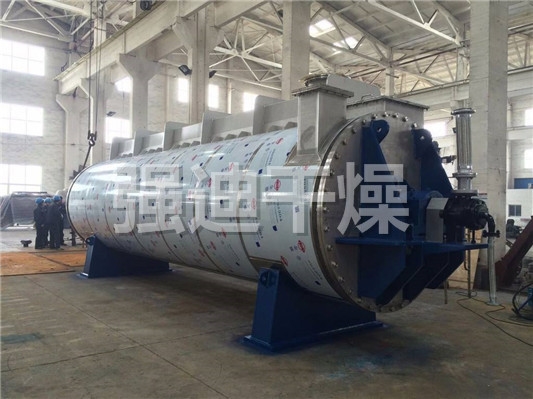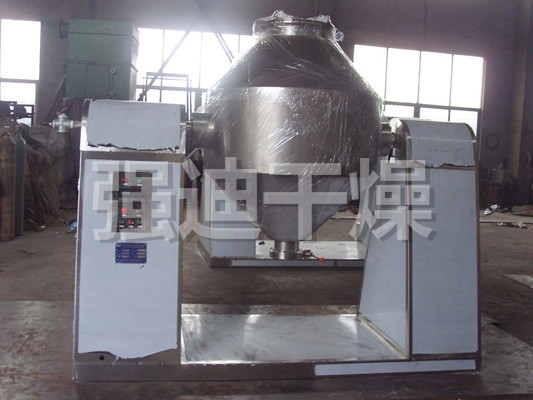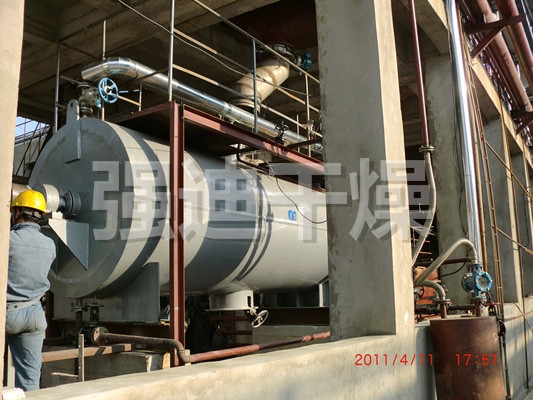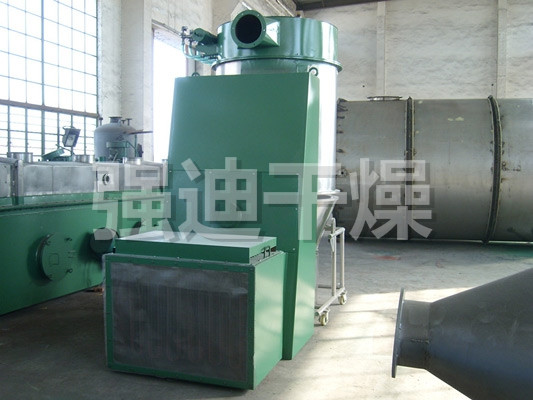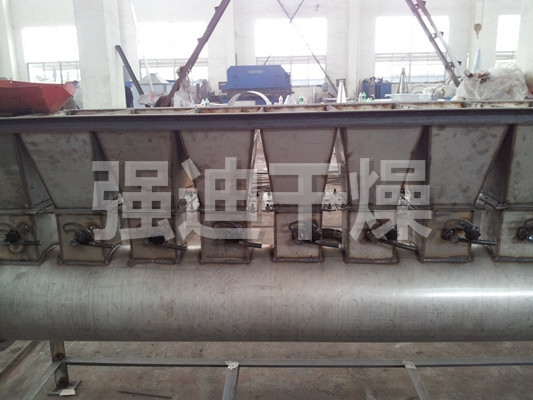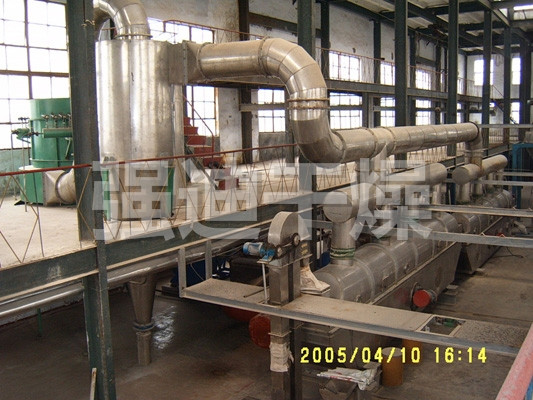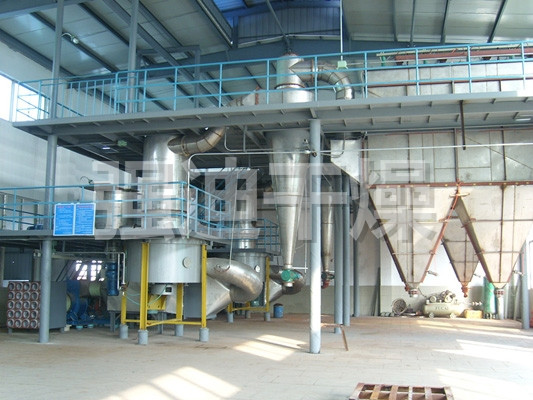Location:Home / News / Technology Center
Technology Center
Research status and development trend of airflow drying technology
2017-05-05 | Browsing:
Changzhou Qiangdi drying equipment co., LTD.
Tags:Drying equipment, dryer
Air dryer is a kind of convection heat transfer drying, also known as "instant drying". During the airflow drying process, the material is dispersed in the heating gas, and at the same time, 2 functions of conveying and drying are completed. Because the dry material is suspended in the fluid, the contact area is large and the heat and mass transfer process is enhanced.。
1Classification of air drying equipment
1.1 Simple straight tube
This is the earliest and the most widely used airstream drying. Its structure is simple and easy to manufacture. It was found that the most effective length of heat and mass transfer was 2-3 m above the inlet, so a short tube dryer with a tube height of only 4-6 m was developed. The latter is widely used in the evaporation of water on the surface of certain materials such as chemicals and building materials.
1.2 Inverted cone
The inverted cone air dryer adopts the structure of the increasing diameter of the air drying tube, so the gas velocity decreases from the bottom to the upper, and the particles with different granularity are suspended in different height in the tube. The wet material is gradually removed and lighter in the drying process, and the material is floating upward. When the particle size and the drying degree reach the requirement, the drying tube is brought out by the air flow. This increases the retention time of the particles in the tube and reduces the height of the air drying tube.
1.3 Pulse type
The diameter of the pulse air drying tube is reduced and expanded alternately, and the velocity of the particles is accelerated and decelerated alternately, making the relative velocity and heat transfer area between the air and the particles larger, thus strengthening the rate of heat and mass transfer. At present, there are 3 types of pulse drier, straight tube expansion pulse tube, conical pulse tube and S type pulse tube.
1.4 Cannula
The drying pipe of the casing drier is not simply a single layer straight pipe, but is composed of inner and outer bushing. The material and air flow of a single sleeve enter from the lower part of the inner tube at the same time, and the particles accelerate in the inner tube. When the acceleration stops, the top of the inner tube leads into the annulus of the inner and outer tubes. In the annulus, particles move at a relatively small speed and then expulse. The drying method can reduce the height of the drying pipe and improve the thermal efficiency.
1.5 Other types
In addition to the above types, there are cyclone, spouting, rotating flash, annular dryer, Venturi tube, swirl and so on.
2 Current research status of air drying technology
Cao Chongwen introduces a basic mathematical model of airflow drying which is widely used. It provides a certain basis for the design and performance analysis of airflow dryer. 5 hypotheses are given: one is that the material is spherical particles, the particle size and water content are uniform; the two is the vertical tube and the horizontal plane; the three is the uniform distribution of the particles in the section of the dry pipe and the uniform air velocity; four is the same direction of the material and the air movement; and the five is the dry tube is adiabatic. Five differential equations were established: heat balance equation, heat transfer equation, mass balance equation, drying rate equation, particle phase momentum equation. It provides theoretical guidance for the design of the actual dry pipe. Jin Guomiao introduced the motion equations of particles in airflow drying (including acceleration and constant velocity) in air drying, and introduced the calculation formula of the heat transfer in the air drying tube and the pressure loss of the air drying tube. It will play a certain reference role in studying the movement law and heat and mass transfer rule of particles in drying tube. Chen Wenjing passes the differential equation of mass heat transfer in the acceleration section of the air flow dryer, and gives some initial variables. It is concluded that the most effective part of the air dryer is the acceleration section, the effect of the heat transfer of the final velocity is very poor, and it should not be used again. By simulating and analyzing several factors under different working conditions, the influence of the influence of hot air temperature, feeding amount and air volume on the drying performance of air flow, and the optimum operating conditions were put forward by Zheng Guosheng. The selection method of gas speed, intake temperature and feed speed of rotary flash dryer was analyzed by Meng Wei and the structure, process and working principle were introduced. Li Junhui and other numerical simulations of air drying of pseudo boehmite straight pipe were carried out. Using the formula proposed by Zheng Guosheng and Cao Chongwen, the curves of material temperature, hot air temperature, particle velocity, hot air humidity, and material moisture content vary with the height of the dry pipe are obtained. Combined with orthogonal test, 4 factors (intake temperature, dry pipe diameter, air velocity and feed speed) are adopted, and the cost and moisture content are adopted. As a result, a relatively economic and low moisture factor combination is obtained. Liang Dong et al. Simulated the heat and mass transfer of wet coal ash in the airflow drying tube. The drying curves of wet ash particles under different airflow drying conditions were obtained and verified and compared with experiments. The following points are put forward: the drying process mainly occurs in the height of about 1m above the inlet of the drying pipe, and then the moisture content of the particles decreases slowly with the increase of the height of the dry pipe, and finally tends to be stable.
3 Development trend of air drying technology
3.1 pecialization of drying equipment
Drying equipment is non-standardized equipment, the reason is non-standardized equipment, mainly deal with material properties and product requirements vary greatly. Therefore, targeted design can make drying equipment play its role, and has a certain significance for technology and economy.
3.2 Development of multistage and combined drying system
Different types of drying equipment can be applied to different materials or suitable for different drying stages. Combined drying (such as air drying and fluidized bed drying) can optimize the drying process to the maximum extent, making the drying system more reasonable.
3.3 Application of energy saving technology
The combination of positive and negative pressure combined type air dryer can effectively utilize the waste heat of the tail gas, reduce the exhaust temperature of the tail gas, increase the discharge after increasing the humidity, and overcome the characteristics of waste heat waste from the tail gas of high temperature and low humidity by single and double stage drying.。
3.4 Multifunction of equipment
Now, the drying equipment is not only limited to the drying operation, but sometimes the crushing, grading and even heating reaction is set in one machine, which greatly shortens the production process and makes the equipment multi-functional.
3.5 mproving the automatic control level of the drying equipment
First, the moisture content of wet material before drying is detected and controlled, and the moisture content of cake is reduced to the lowest stable value by mechanical means. Two, according to the existing heat source conditions, the feed speed of wet material is automatically adjusted under the condition that the maximum inlet temperature can be provided. Through the test of the drying degree of the finished product, the inlet air volume is adjusted to minimize the temperature of the export material, improve the thermal efficiency and reduce the energy consumption.
3.6 Development of simulation software for airflow drying
The China Agricultural University has developed a software Flash, which is specially used for the simulation of air drying. The software can analyze the effect of operating parameters and material parameters on the drying performance. The simulation experiment can be carried out to obtain the changes of the parameters of the material and the drying medium along the tube length, and can be used to assist in designing some structural parameters of the drying tube. Type of software is still to be developed and gradually improved. In addition, using CFD commercial packages, such as Fluent, CFX, PHOENICS, STAR-CD, and so on, the numerical simulation of heat transfer and mass transfer in the drying process has become an important direction of the simulation of air drying.
1Classification of air drying equipment
1.1 Simple straight tube
This is the earliest and the most widely used airstream drying. Its structure is simple and easy to manufacture. It was found that the most effective length of heat and mass transfer was 2-3 m above the inlet, so a short tube dryer with a tube height of only 4-6 m was developed. The latter is widely used in the evaporation of water on the surface of certain materials such as chemicals and building materials.
1.2 Inverted cone
The inverted cone air dryer adopts the structure of the increasing diameter of the air drying tube, so the gas velocity decreases from the bottom to the upper, and the particles with different granularity are suspended in different height in the tube. The wet material is gradually removed and lighter in the drying process, and the material is floating upward. When the particle size and the drying degree reach the requirement, the drying tube is brought out by the air flow. This increases the retention time of the particles in the tube and reduces the height of the air drying tube.
1.3 Pulse type
The diameter of the pulse air drying tube is reduced and expanded alternately, and the velocity of the particles is accelerated and decelerated alternately, making the relative velocity and heat transfer area between the air and the particles larger, thus strengthening the rate of heat and mass transfer. At present, there are 3 types of pulse drier, straight tube expansion pulse tube, conical pulse tube and S type pulse tube.
1.4 Cannula
The drying pipe of the casing drier is not simply a single layer straight pipe, but is composed of inner and outer bushing. The material and air flow of a single sleeve enter from the lower part of the inner tube at the same time, and the particles accelerate in the inner tube. When the acceleration stops, the top of the inner tube leads into the annulus of the inner and outer tubes. In the annulus, particles move at a relatively small speed and then expulse. The drying method can reduce the height of the drying pipe and improve the thermal efficiency.
1.5 Other types
In addition to the above types, there are cyclone, spouting, rotating flash, annular dryer, Venturi tube, swirl and so on.
2 Current research status of air drying technology
Cao Chongwen introduces a basic mathematical model of airflow drying which is widely used. It provides a certain basis for the design and performance analysis of airflow dryer. 5 hypotheses are given: one is that the material is spherical particles, the particle size and water content are uniform; the two is the vertical tube and the horizontal plane; the three is the uniform distribution of the particles in the section of the dry pipe and the uniform air velocity; four is the same direction of the material and the air movement; and the five is the dry tube is adiabatic. Five differential equations were established: heat balance equation, heat transfer equation, mass balance equation, drying rate equation, particle phase momentum equation. It provides theoretical guidance for the design of the actual dry pipe. Jin Guomiao introduced the motion equations of particles in airflow drying (including acceleration and constant velocity) in air drying, and introduced the calculation formula of the heat transfer in the air drying tube and the pressure loss of the air drying tube. It will play a certain reference role in studying the movement law and heat and mass transfer rule of particles in drying tube. Chen Wenjing passes the differential equation of mass heat transfer in the acceleration section of the air flow dryer, and gives some initial variables. It is concluded that the most effective part of the air dryer is the acceleration section, the effect of the heat transfer of the final velocity is very poor, and it should not be used again. By simulating and analyzing several factors under different working conditions, the influence of the influence of hot air temperature, feeding amount and air volume on the drying performance of air flow, and the optimum operating conditions were put forward by Zheng Guosheng. The selection method of gas speed, intake temperature and feed speed of rotary flash dryer was analyzed by Meng Wei and the structure, process and working principle were introduced. Li Junhui and other numerical simulations of air drying of pseudo boehmite straight pipe were carried out. Using the formula proposed by Zheng Guosheng and Cao Chongwen, the curves of material temperature, hot air temperature, particle velocity, hot air humidity, and material moisture content vary with the height of the dry pipe are obtained. Combined with orthogonal test, 4 factors (intake temperature, dry pipe diameter, air velocity and feed speed) are adopted, and the cost and moisture content are adopted. As a result, a relatively economic and low moisture factor combination is obtained. Liang Dong et al. Simulated the heat and mass transfer of wet coal ash in the airflow drying tube. The drying curves of wet ash particles under different airflow drying conditions were obtained and verified and compared with experiments. The following points are put forward: the drying process mainly occurs in the height of about 1m above the inlet of the drying pipe, and then the moisture content of the particles decreases slowly with the increase of the height of the dry pipe, and finally tends to be stable.
3 Development trend of air drying technology
3.1 pecialization of drying equipment
Drying equipment is non-standardized equipment, the reason is non-standardized equipment, mainly deal with material properties and product requirements vary greatly. Therefore, targeted design can make drying equipment play its role, and has a certain significance for technology and economy.
3.2 Development of multistage and combined drying system
Different types of drying equipment can be applied to different materials or suitable for different drying stages. Combined drying (such as air drying and fluidized bed drying) can optimize the drying process to the maximum extent, making the drying system more reasonable.
3.3 Application of energy saving technology
The combination of positive and negative pressure combined type air dryer can effectively utilize the waste heat of the tail gas, reduce the exhaust temperature of the tail gas, increase the discharge after increasing the humidity, and overcome the characteristics of waste heat waste from the tail gas of high temperature and low humidity by single and double stage drying.。
3.4 Multifunction of equipment
Now, the drying equipment is not only limited to the drying operation, but sometimes the crushing, grading and even heating reaction is set in one machine, which greatly shortens the production process and makes the equipment multi-functional.
3.5 mproving the automatic control level of the drying equipment
First, the moisture content of wet material before drying is detected and controlled, and the moisture content of cake is reduced to the lowest stable value by mechanical means. Two, according to the existing heat source conditions, the feed speed of wet material is automatically adjusted under the condition that the maximum inlet temperature can be provided. Through the test of the drying degree of the finished product, the inlet air volume is adjusted to minimize the temperature of the export material, improve the thermal efficiency and reduce the energy consumption.
3.6 Development of simulation software for airflow drying
The China Agricultural University has developed a software Flash, which is specially used for the simulation of air drying. The software can analyze the effect of operating parameters and material parameters on the drying performance. The simulation experiment can be carried out to obtain the changes of the parameters of the material and the drying medium along the tube length, and can be used to assist in designing some structural parameters of the drying tube. Type of software is still to be developed and gradually improved. In addition, using CFD commercial packages, such as Fluent, CFX, PHOENICS, STAR-CD, and so on, the numerical simulation of heat transfer and mass transfer in the drying process has become an important direction of the simulation of air drying.
相关文章
- 2017-05-05 > Xinjiang agricultural and sideline product net belt dryer delivery
- 2017-05-05 > Shenyang Chemical General plant has successfully ordered 4 large 96 square vacuum drying machines.
- 2017-05-05 > Qiang Di is drying with the Chinese Academy of Sciences, making two large flash dryer.
- 2017-05-05 > The hollow paddle dryer ordered by Qinghai Saline Lake has been successfully shipped
- 2017-05-05 > The dry equipment industry in China needs to be integrated in an all-round way
- 2017-05-05 > What trends should enterprises grasp to improve spray drying?
- 2017-05-05 > Liaoyang pigment factory orders our complete set of pigment drying equipment.
- 2017-05-05 > Improved vacuum dryer promotes green upgrading of bulk drug production
- 2017-05-05 > Changes in the market pattern of the drying equipment industry
- 2017-05-05 > Necessary conditions for safe use of hot air circulating oven
Relevant Products




